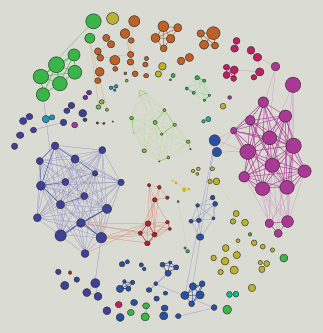Contributed by: Jasmien Lismont, Bart Baesens
This article first appeared in Data Science Briefings, the DataMiningApps newsletter. Subscribe now for free if you want to be the first to receive our feature articles, or follow us @DataMiningApps. Do you also wish to contribute to Data Science Briefings? Shoot us an e-mail over at briefings@dataminingapps.com and let’s get in touch!
Along with big data, social networks are a hot topic nowadays in data science communities. Social networks link items or persons, also called nodes, in a network by means of links, also called edges. For example, person A can be linked to person B if they are friends on Facebook. Now we can derive information about these persons by including those links in our analysis. As such, if person A is interested in data science, person B might also be interested in data science, because A and B communicate frequently. This information might be hard to gather by just looking at person B as a single individual instead of looking at person B as part of a community.
But next to the obvious usefulness of social network analytics (SNA) to companies such as Facebook, Twitter and LinkedIn, these techniques can also be applied in less conventional domains. These domains don’t necessarily contain the social aspect of SNA, with networks where people don’t know each other. They don’t even necessarily have to contain people. This article gives you five examples which hopefully show you that SNA can be applied in different and innovative ways not linked to who likes who and who follows who. Hopefully, it will inspire you to new and creative applications of network analytics.
1. Pseudo-social networks for direct marketing
In [1], Martens et al. propose a pseudo-social network for the purpose of targeting customers. Here, they link customers of a bank if they transferred money for similar reasons, e.g. a bookstore, electricity company, etc. The chance that these customers know each other is small. As such, this network doesn’t represent a real social network. However, the authors prove that SNA can still be useful for targeting purposes as customers who are more closely linked to existing customers are more likely to act on similar offers.
2. Linking healthcare service providers to uncover hidden costs
Healthcare is an important topic of our current society with an aging population and thus a rise in costs. One way to suppress costs is to take a closer look at health insurance claims. For example, Srinivasan and Arunasalam [2] present a network of physiotherapy providers who share patients. Again, these service providers do not necessarily know each other, but they are linked by means of the patients they treat. By studying this network, one can discover unusual behavior by physiotherapists who regularly share large groups of patients.

Figure 1: Network of physiotherapists sharing patients. The colors represent communities of physiotherapist who have a lot of patients in common [2].
3. Creating a citation network to summarize research topics
Qazvinian and Radev [3] have built a citation network where papers are connected if they refer to each other. This would allow them, by means of network analysis techniques, to quickly summarize a certain research topic or domain. This application is not only useful for researchers but for everyone in need of efficient, automatic document summarization where documents can be linked somehow.
4. A transportation network for urban planning
Soh et al. [4] represent travel routes of trains and buses by means of a network for the purpose of urban planning. Hereby, they study the network from a topological perspective. This means that they study the shape, connections, paths, and other topological measures of the graph in order to improve their knowledge of the transportation network. As such, network analytics helps to structure public transport data and solve vital questions for local governments.
5. Employee networks for guiding HR activities
In a company, you can connect your employees with each other by means of communication flows, e.g. e-mails and chats, shared projects and/or shared offices. As such, Baesens et al. [5] explain how we can create a network of employees which we can analyze to discover who your most pivotal or connected employees are. This might guide HR in their firing policies, change management and project management.
The previous 5 examples show you that social networks can be used in different contexts and for different problems. The only requirement is that you’re able to connect the instances you’re interested in by means of social ties or other types of connections, e.g. similar behavior, shared locations or projects, routing, etc. Social network analytics can really make a differences in those cases where we can actually gather more information by linking instances than by treating them independently. This means that in those cases the fact that two instances are closely linked, means that they share some useful features or allow us to deduce useful insights.
References:
- [1] Martens, D., Provost, F., Clark, J., and Junqué de Fortuny, E. (2016). Mining Massive Fine-Grained Behavior to Improve Predictive Analytics. MIS Quarterly 40(4): 869-888.
- [2] Srinivasan, U., and Arunasalam, B. (2013). Leveraging Big Data Analytics to Reduce Healthcare Costs. IT professional: 15(6), p. 21-28. DOI = 10.1109/MITP.2013.55.
- [3] Qazvinian, V., and Radev, D. R. (2008). Scientific Paper Summaziation Using Citation Summary Networks. In COLING ’08 Proceedings of the 22nd International Conference on Computational Linguistics – Volume 1, P. 689-696.
- [4] Soh, H., Lim, S., Zhang, T., Fu, X., Lee, G.K.K., Hung, T.G.G., Di, P., Prakasam, S., and Wong, L. (2010). Weighted Complex Network Analysis of Travel Routes on the Singapore Public Transportation System. Physica A: Statistical Mechanics and its Applications, 389(24): p. 5852-5863. DOI = 10.1016/j.physa.2010.08.015.
- [5] Baesens, B., De Winne, S., and Sels, L. (2016). What to Do Before You Fire a Pivotal Employee. Harvard Business Review. https://hbr.org/2016/01/what-to-do-before-you-fire-a-pivotal-employee.
